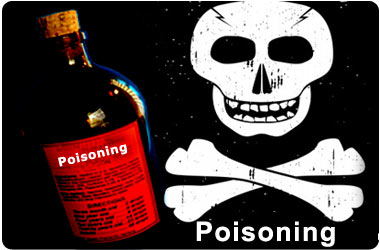
A poison (also referred to as a toxin) is any substance that has a detrimental effect to health which causes possible irreversible damage or death due to its toxic chemical composition and action when it enters the body or when it comes in contact with the skin or mucous membrane. Generally a poisonous substance can come in all states of matter composition namely; solid, liquid, gas and vapor. Ingested poisons account to the majority of recorded poison reports worldwide. This form of poisoning frequently happens to very young children who accidentally take in poisonous substances that are normally found in the household.
[note color=”#6fc1da”]Ingested Poisons[/note]
Ingested poisoning happens when victim, intentionally or unknowingly ingest/swallow a toxic substances. Fortunately, most known household poisons have only negligible effects when ingested in small amounts and that severe poisoning rarely occurs. However, the possibility for severe or fatal poisoning is always a serious threat and should always be properly managed. Approximately 80% of all poisoning reported worldwide are often ingested or swallowed.
[note color=”#6fc1da”]Recognizing Ingested Poisoning [/note]
The common signs of ingested poisoning include but not limited to the following:
- Poison container within the vicinity.
- Abdominal pain and cramping.
- Nausea or vomiting
- Diarrhea
- Burns, odors or stains around and in the oral region.
- Drowsiness
- Unresponsiveness
[note color=”#6fc1da”]Care for Ingested Poisons[/note]
To care for victims who ingested poisonous substances:
- Determine the following:
- The age and the size of the victim
- What was swallowed (read container label, save sample of vomit for analysis).
- If victim is conscious, ask victim how much was swallowed (eg. Number of tablets swallowed and/or container size).
- The time elapsed when the substance swallowed.
Everyday First Aid: Poison and harmful substances
[media url=”http://www.youtube.com/watch?v=L4o6D10AkMg” width=”600″ height=”400″]- For a responsive victim, immediately call the respective poison control center of the region where the poisoning incident occurred. Most poisonings can be treated by following instructions by the telephone operator from the region’s poison control center on what to do and what to give as initial treatment before medical help arrives. The poison control center may advise the caller to dilute the poison, induce vomiting or provide activated charcoal if available.
- The poison control center of the respective region where the call was made will advise the caller to contact emergency medical services for further care and management.
- If victim is unconscious, without pulse and not breathing, initiate CPR in continuous cycles until emergency personnel arrive.
[note color=”#6fc1da”]What is Activated Charcoal?[/note]
Activated charcoal is a fine black, odorless powder that is also available as a liquid which prevents the fast absorption of most poisons and drugs by the stomach and intestines into the blood stream. However, activated charcoal does not absorb all known poisonous drugs and chemicals. Acids and alkalis (ammonia and bleach), potassium, iron, kerosene, methanol, alcohol, cyanide and gasoline require different treatment that must be done at a hospital or specialized facility for treating poisoning. The main drawback of activated charcoal is its appearance and grittiness. As much as possible, never incorporate food additives such as chocolate syrup, ice cream and other sweet substances as it decreases the charcoal’s binding capacity.
To learn more about recognizing and managing serious emergencies such as poisoning enrol in a First Aid and CPR Certification course with one of our training providers. Certification is provided immediately upon successful completion of the course.
[note color=”#6fc1da”]CPR Certificate Reference for First Aid and CPR Management: [/note]
Alton, T. et al (2012). First Aid, CPR and AED Standard 6th Ed. Jones & Bartlett Learning

